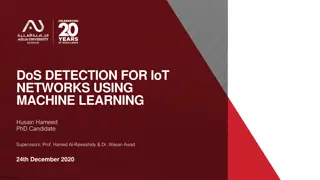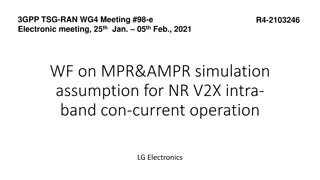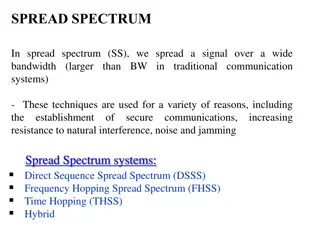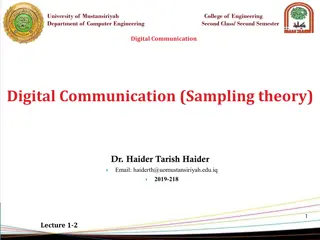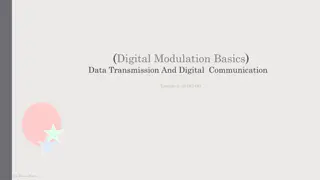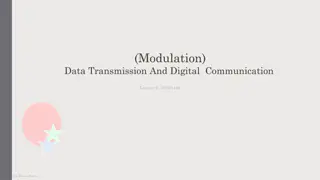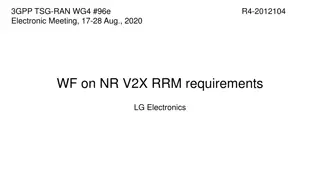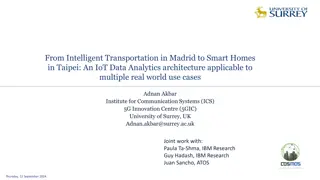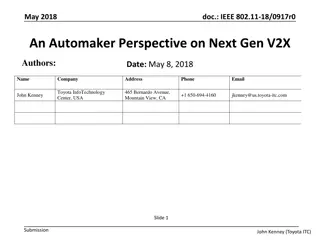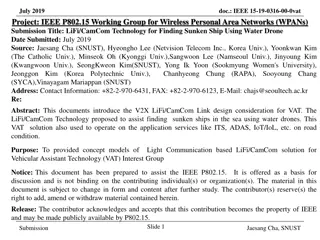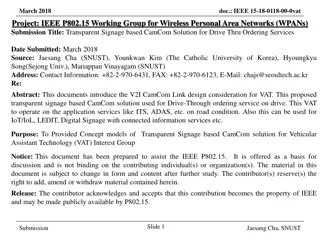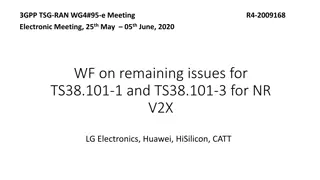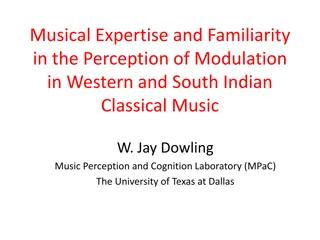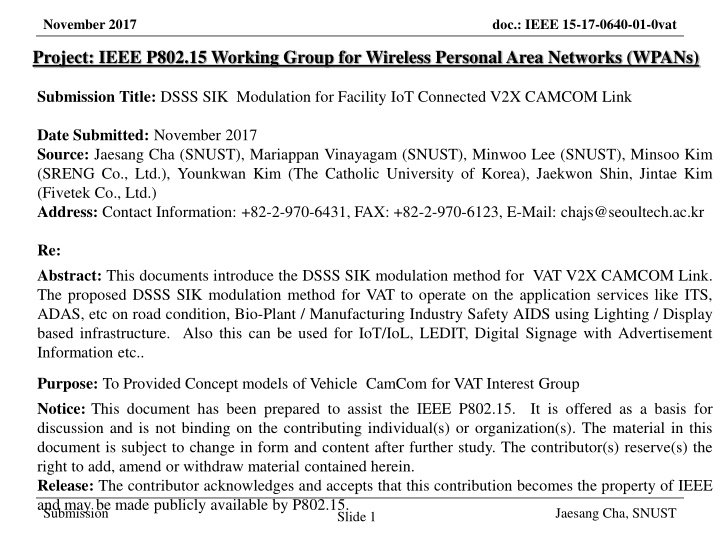
DSSS SIK Modulation for Facility IoT Connected V2X CAMCOM Link
Introducing DSSS SIK modulation for VAT V2X CAMCOM Link, catering to applications like ITS, ADAS, Bio-Plant Safety, and more. This document explores the technical aspects and needs of the V2X CAMCOM system, highlighting efficient modulation methods and addressing noise and interference issues.
Download Presentation

Please find below an Image/Link to download the presentation.
The content on the website is provided AS IS for your information and personal use only. It may not be sold, licensed, or shared on other websites without obtaining consent from the author. If you encounter any issues during the download, it is possible that the publisher has removed the file from their server.
You are allowed to download the files provided on this website for personal or commercial use, subject to the condition that they are used lawfully. All files are the property of their respective owners.
The content on the website is provided AS IS for your information and personal use only. It may not be sold, licensed, or shared on other websites without obtaining consent from the author.
E N D
Presentation Transcript
November 2017 doc.: IEEE 15-17-0640-01-0vat Project: IEEE P802.15 Working Group for Wireless Personal Area Networks (WPANs) Submission Title: DSSS SIK Modulation for Facility IoT Connected V2X CAMCOM Link Date Submitted: November 2017 Source: Jaesang Cha (SNUST), Mariappan Vinayagam (SNUST), Minwoo Lee (SNUST), Minsoo Kim (SRENG Co., Ltd.), Younkwan Kim (The Catholic University of Korea), Jaekwon Shin, Jintae Kim (Fivetek Co., Ltd.) Address: Contact Information: +82-2-970-6431, FAX: +82-2-970-6123, E-Mail: chajs@seoultech.ac.kr Re: Abstract: This documents introduce the DSSS SIK modulation method for VAT V2X CAMCOM Link. The proposed DSSS SIK modulation method for VAT to operate on the application services like ITS, ADAS, etc on road condition, Bio-Plant / Manufacturing Industry Safety AIDS using Lighting / Display based infrastructure. Also this can be used for IoT/IoL, LEDIT, Digital Signage with Advertisement Information etc.. Purpose: To Provided Concept models of Vehicle CamCom for VAT Interest Group Notice: This document has been prepared to assist the IEEE P802.15. It is offered as a basis for discussion and is not binding on the contributing individual(s) or organization(s). The material in this document is subject to change in form and content after further study. The contributor(s) reserve(s) the right to add, amend or withdraw material contained herein. Release: The contributor acknowledges and accepts that this contribution becomes the property of IEEE and may be made publicly available by P802.15. Slide 1 Submission Jaesang Cha, SNUST
November 2017 doc.: IEEE 15-17-0640-01-0vat Contents V2X CAMCOM Link System V2X CAMCOM Link Needs DSSS SIK Conclusion Submission Jaesang Cha, SNUST
November 2017 doc.: IEEE 15-17-0640-01-0vat V2X CAMCOM Link System Vehicle-to-Infrastructure (V2I) CAMCOM Technology Vehicle-to-Vehicle (V2V) CAMCOM Technology Image Sensor based V2X Communication - Tx - LED ; Rx - CMOS Image Sensor - Data Rate : 10 Mb/s - Day-Night Communication Mode Submission Jaesang Cha, SNUST
November 2017 doc.: IEEE 15-17-0640-01-0vat V2X CAMCOM Link Needs (1) Issues Needs to be address in design Minimizing the effect of external noise Artificial or Natural Ambient lights effect Interference minimization Robust Modulation Need Robust Modulation Techniques CamCom Link in ITS is largely affected by natural and artificial lights (noise and interference) such as Sunlight, ambient lights, road/street lights etc. Different Modulation used including Optical MIMO Adaptive Modulation Techniques for different applications Equalization Techniques have advantages in design Submission Jaesang Cha, SNUST
November 2017 doc.: IEEE 15-17-0640-01-0vat V2X CAMCOM Link Needs (2) Efficient Modulation Methods Considered OOK Multilevel PPM Inverted PPM Sub Carrier PPM DSSS SIK Submission Jaesang Cha, SNUST
November 2017 doc.: IEEE 15-17-0640-01-0vat DSSS SIK (1) Direct Sequence Spread Spectrum (DSS) Sequence Inverse- Keying (SIK) Spectrum spreading is accomplished before transmission through the use of a spreading code that is independent of the data sequence The same spreading code is used in the receiver (operating in synchronism with the transmitter) to de-spread the received signal so that the original data may be recovered. Submission Jaesang Cha, SNUST
November 2017 doc.: IEEE 15-17-0640-01-0vat DSSS SIK (2) "VIDAS D4.1: Modulation Schemes for outdoor visible-light communication systems" by Navin Kumar, 2010 Submission Jaesang Cha, SNUST
November 2017 doc.: IEEE 15-17-0640-01-0vat DSSS SIK (3) DSSS uses bipolar spreading sequences that cannot be used as such in the all- positive (unipolar) optical medium Because in optical medium there is no negative going pulses and when there is no light pulse, the signal has to be represented by zero level Therefore, a technique called unipolar-bipolar sequencing, allows the same spreading codes of radio systems to be used in optical systems, is employed instead Submission Jaesang Cha, SNUST
November 2017 doc.: IEEE 15-17-0640-01-0vat DSSS SIK (4) Unipolar-bipolar sequencing, involves transmission of a unipolar spreading sequence and correlation with a bipolar version of the same spreading sequence, preserves the correlation properties of bipolar-bipolar sequencing although with the introduction of a fixed dc offset. At the transmitter, a unipolar spreading sequence is modulated by binary data such that the sequence is transmitted for a binary 1 while the inverse (complement) sequence is transmitted for a binary 0 . This type of modulation is called as SIK. The resulting spread spectrum signal uses a rectangular NRZ chip waveform to modulate the intensity of the visible light source (LEDs). Submission Jaesang Cha, SNUST
November 2017 doc.: IEEE 15-17-0640-01-0vat DSSS SIK (5) Minimize the effect of interference according to the processing gain advantage While the additional bandwidth requirement of a spread-spectrum modulation scheme reduces the system bandwidth efficiency the processing gain of the spread spectrum technique helps to Combat artificial light interference effects Multipath dispersion (if any) without the need for extra circuitry such as equalizers. Submission Jaesang Cha, SNUST
November 2017 doc.: IEEE 15-17-0640-01-0vat Conclusion Introduced the Effective Modulation method called DSSS SIK for V2X CAMCOM Link V2X CAMCOM Link guarantees data communication from infrastructure-to-vehicle and vehicle-to vehicle, broadcasting many safety related information, hence suitable for road safety applications. Submission Jaesang Cha, SNUST

